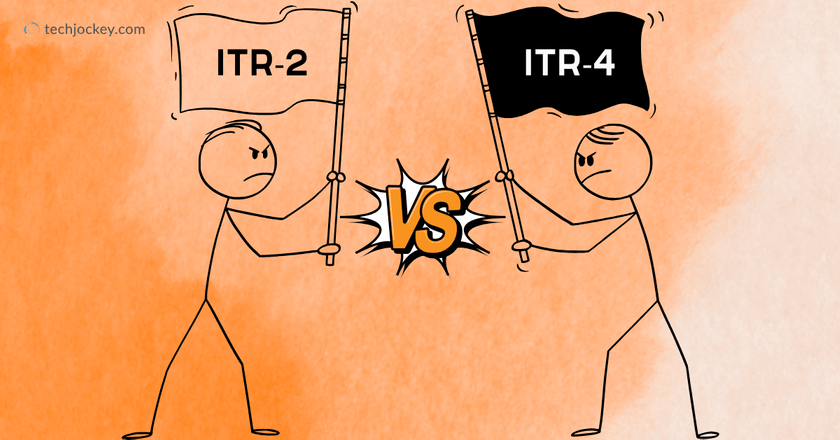You have got the income. You have got the documents. But which ITR form do you file? It is a standard tax query that many individuals and Hindu Undivided Families (HUFs) face every year. With multiple forms available, it is pretty easy to feel unsure, especially when it comes to choosing between ITR-2 and ITR-4.
For the said two forms might seem similar on the surface to many, but they serve distinct purposes when looked at closely. So, let’s dig deeper and try and discern the difference between ITR-2 vs ITR-4 to make tax filing easier for all.
What are ITR-2 and ITR-4?
ITR-2 is designed for individuals and HUFs who have income from sources other than business or profession profits. If your income primarily includes salary, pension, multiple house properties, capital gains, foreign assets or income, or even agricultural income exceeding INR 5,000, ITR-2 is likely the form for you.
To put it simply, ITR-2 is apt for those who…
- Earn salary or pension income
- Have income from multiple house properties
- Own capital gains from securities or assets
- Have income from other sources, including winnings from lotteries or legal gambling
- Have foreign income or assets
- Are Directors in a company or have investments in unlisted shares
- Are Resident but Not Ordinarily Resident (RNOR) or Non-Resident Indians (NRIs)
- Need to club income from a spouse or minor child within these categories
However, ITR-2 is not for taxpayers with profits and gains from business or profession activities. Those individuals need to consider other forms, depending on their business income reporting method. This makes ITR-2 an extensive form for non-business income sources yet intricate for those with capital gains and foreign assets to report.
Suggested Read: How to File ITR-2 – Step-by-Step Guide
ITR-4, also known as Sugam, on the contrary, is an ITR form meant for resident individuals, HUFs, or firms (other than LLPs) who earn income from business or profession on a presumptive basis. This form is designed to make tax compliance easy for small businesses and professionals, as it allows them to declare income on presumptive taxation schemes under Sections 44AD, 44ADA, and 44AE of the Income Tax Act.

ClearTax Income Tax
Starting Price
Price on Request
ITR-4 suits taxpayers who…
- Have income from business or profession but opt for presumptive taxation
- Have a turnover or gross receipts up to INR 50 lakhs
- Earn income from salary, one house property, and capital gains up to INR 1.25 lakh (under Section 112A)
- Do not maintain detailed books of accounts
- Want to avoid the complexity of tax audits (as ITR-4 filers are generally exempt if income limits are respected)
This form caters especially to small traders, freelancers, and professionals who want a simpler compliance process without worrying about paperwork. However, ITR-4 is not suitable if you have income under other heads like multiple house properties or if your income from business/profession does not fall under the presumptive scheme.
Suggested Read: How to File ITR-4 – A Step-by-Step Guide
ITR-2 vs ITR-4: Quick Comparison Table for Tax Filing
| Aspect | ITR-2 | ITR-4 (Sugam) |
|---|---|---|
| Eligibility | Individuals & HUFs with **non-business income** | Residents, HUFs & Firms (other than LLPs) with business/professional income under presumptive taxation, income ≤ ₹50 lakh |
| Income Sources | Salary, multiple house properties, capital gains, other sources, foreign assets | Business/professional income under presumptive taxation, salary, one house property, other sources, long-term capital gains (≤ ₹1.25 lakh) |
| Audit & Complexity | Detailed disclosures required; may attract audit if business income exists | Simpler compliance; generally exempt from audit under presumptive scheme |
| Foreign Income | Allowed | Not allowed |
| Capital Gains | Both short-term & long-term allowed | Only long-term capital gains under Section 112A, ≤ ₹1.25 lakh |
| House Property | Multiple properties allowed | Limited to one property |
| Agricultural Income | Exceeding ₹5,000 allowed | Up to ₹5,000 only |
ITR-2 vs ITR-4: Key Differences Explained
When comparing ITR-2 vs ITR-4, the fundamental differences lie in the following aspects…
- Income Source: ITR-2 is for those without business or professional income, focusing on salary, capital gains, multiple house properties, and foreign income. Conversely, ITR-4 is designed for business or professional income reported under presumptive taxation schemes.
- Presumptive Taxation: Only ITR-4 allows declaring income on a presumptive basis under Sections 44AD, 44ADA, and 44AE, simplifying taxation for small businesses and professionals. ITR-2 does not accommodate this.
- Complexity & Disclosures: Filing ITR-2 requires detailed disclosure of capital gains, foreign assets, multiple house properties, and more, making it comparatively complex. ITR-4, on the othe rhand, is user-friendly with fewer disclosure requirements.
- Eligibility & Income Limits: Taxpayers with business turnover above INR 50 lakhs or maintaining detailed books should not file ITR-4, while ITR-2 has no presumptive income limitation but excludes business income altogether.
- Audit Requirement: ITR-4 filers opting for presumptive taxation generally are exempt from audit requirements, unlike those who file ITR-2 with business income which can attract audits if thresholds are crossed.
- Number of House Properties: ITR-2 allows reporting income from any number of house properties, while ITR-4 is limited to income from only one house property.
- Capital Gains & Foreign Income: ITR-2 caters to taxpayers with capital gains and foreign income or assets, whereas ITR-4 limits capital gains reporting and excludes foreign income.
How to Decide Between ITR-2 and ITR-4?
Making the right choice between ITR-2 and ITR-4 depends on understanding where your income comes from and how it is reported…
- Assess Sources of Income: If your income sources include salary, capital gains, multiple house properties, foreign assets, or passive incomes without business profits, ITR-2 is the right choice.
- Determine If You Have Business Income: Income from business or profession generally requires ITR-3 or ITR-4. But if you opt for presumptive taxation (a simpler, lump-sum method), ITR-4 applies. For detailed business income reporting, ITR-2 is not applicable.
- Check Turnover & Complexity: If your business turnover exceeds INR 50 lakh or you maintain books and undergo audits, avoid ITR-4 and consider the other forms. If turnover is within INR 50 lakh and presumptive tax suits your case, ITR-4 simplifies compliance.
- Consider Capital Gains & Foreign Income: Only file ITR-2 if you have capital gains or foreign income/assets to declare.
- Limitations on House Property Income: If you own multiple house properties, you cannot declare this in ITR-4; use ITR-2 instead.
- Review Tax Audit Requirements: If you are subject to tax audit due to your business or profession income, ITR-4 is not appropriate.
Conclusion
Understanding the ITR-2 vs ITR-4 debate thus is significant for anyone trying to make sense of the tax filing process in India. For only when you choose the right form can you file your taxes properly and on time.
If technical aid is what you seek, give the Techjockey team a call today and get the best income tax software working for you in minutes!
Yashika Aneja is a Senior Content Writer at Techjockey, with over 5 years of experience in content creation and management. From writing about normal everyday affairs to profound fact-based stories on wide-ranging themes, including environment, technology, education, politics, social media, travel, lifestyle so on and so forth, she... Read more





























